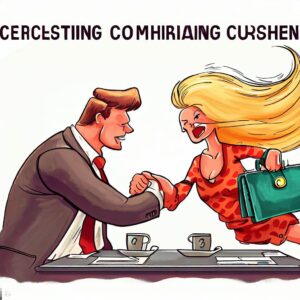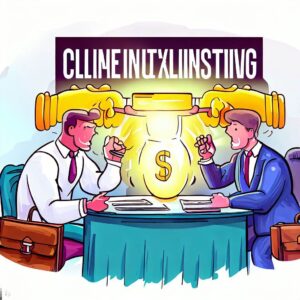In any sales process, closing the sale is often viewed as the end goal. However, this perception leads to a lack of support for clients after they have made their purchase, which can ultimately hinder the success of both the client and the salesperson. This is where Consultative Closing comes into play. It prioritizes the well-being of the client and focuses on maximizing their investment in the product or service. This approach requires a shift in mindset from solely focusing on the sale to providing ongoing support to ensure that clients are getting the most out of their purchase.
Maximizing Investment and Building Strong Client Relationships: The Power of Consultative Closing

In the world of sales, there is a common misconception that once the deal has been closed, the work is done. Sales professionals often focus solely on getting the sale and neglect to provide support to their customers after the purchase has been made. This lack of ‘‘after the sale’’ structure creates a problem for both the salesperson and the client when it comes to maximizing the investment in the product or service.
The goal of Consultative Closing is to partner with clients to help them maximize their investment in the product or service. It is not enough to simply show someone how to use the product or service; sales professionals must go beyond that and work with their clients to ensure that they are getting the most out of their investment. This requires a shift in mindset from focusing solely on the sale to prioritizing the well-being of the client.
Sales professionals often put on a great show when wooing potential clients. They dress up, look sharp, and act super sweet, but as soon as the client buys, everything changes. The salesperson and the company become scarce and less attentive, leaving the client struggling to figure things out on their own. This lack of support can result in nominal results and frustration for the client.
A key aspect of Consultative Closing is providing an ‘‘owner’s manual’’ for how to maximize the investment in the product or service. It is crucial to assume that the client may not know how to use the product or service to its full potential and provide guidance accordingly. For example, if a radio station sells ad space to a business, they should provide guidance on what to put in the ad, how to make it effective, how to capture customer information, and how to sell to those customers effectively. This guidance ensures that the client is set up for success and is more likely to see a return on their investment.
One of the reasons why salespeople don’t focus on the After-the-Sale process is that they are afraid to hear the results. They may worry that if they do a follow-up meeting and the client is upset because things aren’t working, it will reflect poorly on them. It’s easier to keep quiet and hope for the best. However, this approach does not benefit anyone in the long run. It is better to address any issues as soon as possible and work with the client to find a solution.
Another reason why salespeople neglect the After-the-Sale process is that they are not really sure how to help the client maximize their purchase. Sales professionals must be knowledgeable about the product or service they are selling and understand how it can be used to its full potential. This requires ongoing training and education to stay up to date on the latest trends and techniques.
Salespeople may also be primarily interested in their own well-being rather than focusing on the well-being of their clients. Clients are just as self-centered as salespeople are, but the burden is on the salesperson to focus on the things that matter most to the client. This means prioritizing their success and providing support even after the sale has been made.
Finally, salespeople may be compensated based on getting the ‘‘next kill.’’ Once they’ve made the sale, they move on to the next one with no time to turn around and make sure the client is maximizing their investment. However, this short-sighted approach does not benefit anyone. Building long-term relationships with clients should be a priority for sales professionals, and that requires a commitment to supporting them beyond the initial sale.
Consultative Closing by Focusing on After the Sale is crucial for maximizing the investment in a product or service. Sales professionals must shift their mindset from focusing solely on the sale to prioritizing the well-being of their clients. Providing an ‘‘owner’s manual’’ for the product or service, addressing any issues promptly, staying up to date on the latest trends, prioritizing the success of the client, and building long-term relationships are all key components of this approach. By embracing Consultative Closing, sales professionals can build stronger relationships with their clients and help them achieve greater success.
Maximizing Sales Success: The Power of Post-Sale Strategies and Client Engagement

The key to improving our sales lies in focusing more on what happens after the sale is made. To do this, we need to create a “Maximizer Manual” for everything that the client buys. This manual goes beyond a simple owner’s manual and gives clients tips on how to maximize the investment they just made. It also includes post-buy steps that we should set up to help them get the most out of their purchase.
The Maximizer Manual should be delivered with a special gift as a way of welcoming the client into the family and making the first-time buy a big thing. This is especially important if we want to form a long-term relationship with the client.
After the sale is completed, we need to have scheduled “check-ups” with the client to ensure they are experiencing the benefits of our product or service and to address any challenges or problems they may have encountered. We can also use these check-ups as opportunities to up-sell clients into additional products or services and to get referrals.
To make sure we don’t overlook anything, we can develop several follow-up check-lists and surveys to help solicit the type of feedback we need. Even if we sell a service that is basically complete at the point of closing, such as the mortgage business, we can still come up with a post-closing check-up meeting to get feedback on ways we could improve.
All of these follow-up tools and meetings need to be listed on our timeline as mini-steps and talked about before the sale to help with closing. This sends a clear signal to the client that we’re not going to run away, and that in fact, the partnership is just beginning.
We need to break out these post-buy events into tangible action-oriented mini-steps and treat them like we do the pre-buy steps: define deliverables, assign responsibility, pick rough delivery dates, and so forth. These are particularly important indicators of our chances for closing the deal. If the client takes action on a post-buy mini-step, it’s a strong indicator we’re at a YES. If the client won’t take action, it’s a strong indicator that we’re at a NO.
Focusing more on what happens after the sale is made can greatly improve our sales. By creating a Maximizer Manual for everything the client buys, scheduling post-sale check-up meetings, and developing follow-up tools and meetings as mini-steps, we can ensure clients get the most out of their purchase, improve our chances for closing the deal, and form long-term relationships with our clients.
Maximizing Product or Service Success: Strategies for Client Engagement and Ongoing Referrals

In order to ensure that your product or service is being used at a maximized level, it’s important to ask yourself what steps you would take if you were the customer. By taking these same steps and providing tools, information, meetings, and personal involvement, you can help your clients achieve the same level of success with your product or service.
If you have a renewable type of product or service where clients are locked down over a series of weeks, months, or years, it’s important to create a maximization process that accomplishes several objectives. This includes ensuring that they’re maximizing their initial buy, keeping the competition at bay, taking the client’s temperature on a regular basis to prevent issues from turning into bigger problems, and locking clients into a perpetual business relationship that will lead to ongoing referrals.
One of the keys to achieving these objectives is identifying client “touch points.” These are purposeful points of contact that you need to make with the client between selling cycles, whether it’s over a two-week period or over a year. Touch points can include personal meetings, phone calls, e-mails, gifts, or social occasions.
To effectively manage touch points, it can be helpful to lay out a timeline starting with the initial sale and ending with the renewal (next sale). Get index cards and write the touch points on the cards, laying out the cards on the line between Points 1 and 2. Come up with some objectives for the touch points, such as what you are going to review in your quarterly “check-ups.”
By documenting these steps and turning them into a presentation document, you can help clients see a tangible ROI and differentiate yourself from the competition. It’s also important to give clients ideas that will make them money and provide them with a plan or maximization guide to follow after the sale.
When it comes to consultative closing, it’s important to start scheduling post-buy Mini-Steps as part of your defined process. These are like Mini-Steps elsewhere: If clients take action, or they don’t take action, they’ll be “telling” you where they truly are in the decision-making process.
The owner’s manual for your product or service shouldn’t just cover the basics of how to use it; it should also contain strategies for maximizing it. For example, an owner’s manual for a new suit could provide tips on when to wear what and why, how to match it with different accessories, and more.
Overall, by focusing on maximizing your product or service and providing ongoing support to your clients, you can build a solid relationship that will last and lead to ongoing referrals and business growth.
Conclusion
Maximizing sales success requires shifting focus towards what happens after the sale is made. By developing a Maximizer Manual, scheduling post-sale check-ups, identifying client touchpoints, and providing ongoing support, sales professionals can ensure that their clients are achieving the maximum benefit from their investment. Prioritizing client success and building long-term relationships is key to success in the world of sales. Consultative Closing provides the framework necessary for sales professionals to achieve these goals and truly maximize their sales potential.
Sources:
- richardson.com: discusses the importance of emotional intelligence in sales and understanding the client’s emotional responses.
- teamgate.com: provides tips for lead qualification and using pre-framing and open-ended questions to understand the client’s needs.
- mailshake.com: emphasizes the importance of being patient and following up with prospects to close the sale.
